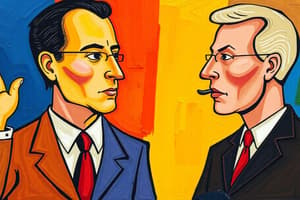Podcast
Questions and Answers
In what scenario would an autocratic leadership style be MOST effective?
In what scenario would an autocratic leadership style be MOST effective?
- Brainstorming sessions requiring innovative solutions.
- Developing a long-term strategic business plan.
- Managing a team of highly skilled researchers.
- Responding to an immediate safety hazard on a construction site. (correct)
Which statement accurately contrasts communication flow in autocratic versus democratic leadership?
Which statement accurately contrasts communication flow in autocratic versus democratic leadership?
- Both autocratic and democratic leadership styles promote equal communication flow among all team members.
- Neither autocratic nor democratic leadership prioritizes formal communication channels.
- Autocratic leadership features two-way communication, while democratic leadership relies on one-way communication.
- Communication flows primarily from top-down in autocratic leadership, while democratic leadership encourages open dialogue. (correct)
What is a potential negative outcome of democratic leadership?
What is a potential negative outcome of democratic leadership?
- Increased dependence on the leader's expertise.
- Decreased employee job satisfaction due to lack of autonomy.
- Slower decision-making processes. (correct)
- Reduced innovation and creativity within the team.
What is the MOST likely consequence of consistently using an autocratic leadership approach?
What is the MOST likely consequence of consistently using an autocratic leadership approach?
How might a project manager effectively use democratic leadership?
How might a project manager effectively use democratic leadership?
How does the nature of the task influence the selection of a leadership style?
How does the nature of the task influence the selection of a leadership style?
Why might a newly appointed CEO adopt an autocratic style in a crisis?
Why might a newly appointed CEO adopt an autocratic style in a crisis?
What is a potential risk associated with democratic leadership related to group dynamics?
What is a potential risk associated with democratic leadership related to group dynamics?
In which scenario is autocratic leadership LEAST appropriate?
In which scenario is autocratic leadership LEAST appropriate?
How does a leader's personality influence their choice of leadership style?
How does a leader's personality influence their choice of leadership style?
What BEST describes situational leadership?
What BEST describes situational leadership?
What is the BEST way to describe a 'hybrid' leadership approach?
What is the BEST way to describe a 'hybrid' leadership approach?
What is the MOST important characteristic of autocratic leadership?
What is the MOST important characteristic of autocratic leadership?
How would a teacher use democratic leadership in the classroom?
How would a teacher use democratic leadership in the classroom?
Which leadership style offers a middle ground between Autocratic and Laissez-faire?
Which leadership style offers a middle ground between Autocratic and Laissez-faire?
Flashcards
Autocratic Leadership
Autocratic Leadership
A leadership style with centralized decision-making and control by the leader alone.
Democratic Leadership
Democratic Leadership
A leadership style involving subordinates in the decision-making process.
Autocratic Decision-Making
Autocratic Decision-Making
Leaders make decisions unilaterally with little to no input from subordinates.
Democratic Decision-Making
Democratic Decision-Making
Signup and view all the flashcards
Communication in Autocratic Leadership:
Communication in Autocratic Leadership:
Signup and view all the flashcards
Communication in Democratic Leadership:
Communication in Democratic Leadership:
Signup and view all the flashcards
When to use Autocratic Leadership
When to use Autocratic Leadership
Signup and view all the flashcards
Benefits of Democratic Leadership:
Benefits of Democratic Leadership:
Signup and view all the flashcards
Drawbacks of Autocratic Leadership:
Drawbacks of Autocratic Leadership:
Signup and view all the flashcards
Decision-Making Speed: Democratic
Decision-Making Speed: Democratic
Signup and view all the flashcards
Decision-Making Speed: Autocratic
Decision-Making Speed: Autocratic
Signup and view all the flashcards
Autocratic Leadership impact on creativity:
Autocratic Leadership impact on creativity:
Signup and view all the flashcards
Democratic Leadership impact on creativity
Democratic Leadership impact on creativity
Signup and view all the flashcards
Situational Leadership:
Situational Leadership:
Signup and view all the flashcards
Hybrid Leadership:
Hybrid Leadership:
Signup and view all the flashcards
Study Notes
- Autocratic leadership features centralized decision-making and control
- The leader independently decides, with little to no subordinate input
- Democratic leadership, also known as participative leadership, involves subordinates in decision-making
- The leader encourages input from team members and considers their perspectives before a final decision
Autocratic Leadership
- Autocratic leaders maintain strict control over teams
- They expect obedience and compliance from subordinates
- Communication typically flows top-down, with limited upward feedback
- This style can be effective in situations requiring quick decisions or when dealing with unskilled workers
- Autocratic leadership is often associated with higher stress and dissatisfaction among employees
Democratic Leadership
- Democratic leaders foster collaboration and teamwork in organizations
- They value input from team members and empower them to take ownership of work
- Communication flows both ways, with open dialogue and feedback encouraged
- This style can lead to higher job satisfaction, motivation, and creativity among employees
- Democratic leadership decision-making may be slower compared to autocratic leadership
Key Differences
- Decision-Making: Autocratic leaders make decisions unilaterally, while democratic leaders involve others
- Control: Autocratic leaders maintain strict control, while democratic leaders empower subordinates
- Communication: Autocratic leadership features one-way communication, while democratic leadership involves two-way communication
- Employee Involvement: Autocratic leadership limits employee involvement, while democratic leadership encourages it
- Speed of Decision-Making: Decisions are typically made faster under autocratic leadership
- Employee Morale: Democratic leadership usually leads to higher morale and job satisfaction
Advantages of Autocratic Leadership
- Quick Decision-Making: Autocratic leaders can make decisions rapidly, beneficial in time-sensitive situations
- Clear Direction: Subordinates know exactly what is expected, reducing confusion and ambiguity
- Efficiency: Autocratic leadership can be efficient when tasks are routine and require little input from employees
- Suitability for Unskilled Workers: This style may be effective when managing employees who lack expertise or experience
Disadvantages of Autocratic Leadership
- Low Morale: Employees may feel undervalued and unmotivated due to lack of input in decision-making
- Lack of Creativity: Limited input from subordinates can stifle creativity and innovation
- High Turnover: Dissatisfied employees may be more likely to leave the organization
- Dependence on Leader: The organization may become overly reliant on the leader's skills and knowledge
Advantages of Democratic Leadership
- Increased Morale: Employees feel valued and motivated when their input is considered
- Enhanced Creativity: Diverse perspectives can lead to more innovative solutions
- Higher Retention: Satisfied employees are more likely to stay with the organization
- Skill Development: Employees develop new skills and knowledge through participation in decision-making
Disadvantages of Democratic Leadership
- Slower Decision-Making: Involving others in decision-making can be time-consuming
- Potential for Conflict: Differing opinions can lead to conflicts and disagreements
- Risk of Groupthink: There is a risk that the group may prioritize consensus over critical thinking
- Not Suitable for All Situations: Democratic leadership may not be appropriate in crisis situations or when dealing with unskilled workers
Factors Influencing Choice of Leadership Style
- Nature of the Task: Routine tasks may be better suited to autocratic leadership, while complex tasks may benefit from democratic leadership
- Skills and Experience of Employees: Autocratic leadership may be effective with unskilled workers, while democratic leadership is more appropriate for skilled and experienced employees
- Time Constraints: In time-sensitive situations, autocratic leadership may be necessary
- Organizational Culture: The prevailing organizational culture can influence the effectiveness of different leadership styles
- Leader's Personality: A leader's personality and preferences can also play a role in their choice of leadership style
Examples of Autocratic Leadership
- Military commanders often use an autocratic style to ensure discipline and obedience
- In crisis situations, a CEO may adopt an autocratic approach to make quick decisions and take decisive action
- A construction foreman may use autocratic leadership to direct workers on a construction site
Examples of Democratic Leadership
- A project manager may involve team members in planning and decision-making processes
- A teacher may encourage students to participate in classroom discussions and activities
- A CEO may solicit input from employees on strategic initiatives
The Continuum of Leadership Styles
- Leadership styles exist on a continuum, ranging from autocratic to laissez-faire
- Autocratic leadership is at one extreme, with the leader making all decisions independently
- Democratic leadership falls in the middle, with the leader involving others in decision-making
- Laissez-faire leadership is at the other extreme, with the leader providing minimal guidance or direction
Situational Leadership
- Situational leadership involves adapting one's leadership style to the specific needs and circumstances
- A situational leader may use an autocratic style in one situation and a democratic style in another, depending on the task, the employees, and the time constraints
- Effective leaders are able to assess the situation and choose the most appropriate leadership style
Hybrid Approaches
- Some leaders adopt hybrid approaches that combine elements of both autocratic and democratic leadership
- For example, a leader may make final decisions independently but solicit input from subordinates before doing so
- Hybrid approaches balance the need for control with the desire for employee involvement
Studying That Suits You
Use AI to generate personalized quizzes and flashcards to suit your learning preferences.




